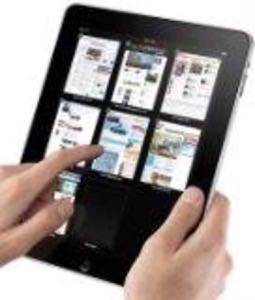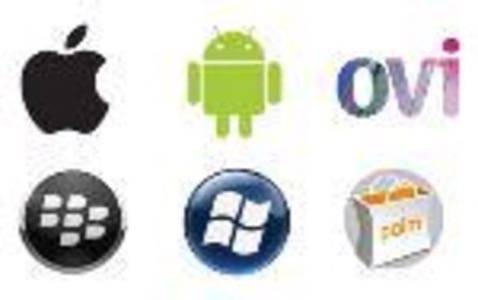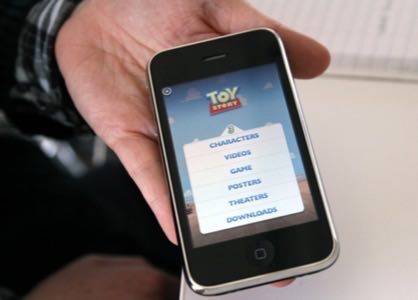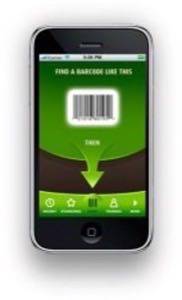Mobile technology has seen major advances over the course of 2010, with new platforms, new services and new usage trends all taking hold to spread the adoption of not just the mobile Web, but the Web itself. The number of smartphone owners are increasing, mobile operating systems are proliferating and apps have become the new go-to tools for accessing mobile content on the go.

When you look back at the past 12 months, it’s almost hard to narrow a list down to only 10 top products, in fact – there’s so much innovation happening around mobile today. But we think the list below stands out as representative of the most important products from the year.
iPhone 4
In June, Apple CEO Steve Jobs introduced the newest iPhone at a packed press event in San Francisco. The iPhone 4 introduced a number of mobile innovations, including front-facing cameras for the phone’s new Facetime video chat feature; gyroscopic controls that let developers create more advanced games and other apps using location and the position of the device in 3D space; an updated OS that introduced multi-tasking; app folders; and more, and perhaps most memorably, an updated design where the antenna wrapped around the outside of the phone, leading to degraded performance. Ah yes, Antennagate 2010, which only showed that not only can Apple make mistakes, doing so has no impact on its sales whatsoever. iPhone 4 sales reached record numbers, despite the buzz around its signal issues.

“Apple’s continued success proves 1) apps and the Web are becoming more important than the ability to make a voice call; 2) consumers have little problem with Apple’s heavy handed control of the end-to-end experience, in fact they appreciate it; 3) no one has come close to matching Apple’s alchemy of great hardware, software, and marketing,” explains Charles Golvin, an analyst at Forrester Research.
iPad
Apple’s introduction of the iPad in March, to put it simply, has forever reshaped the mobile computing landscape. The iPad is part mobile (it runs the iPhone operating system, now called iOS instead of iPhone OS), and part “real” computer (you can do actual work on it using Apple’s office suite). In other words, the iPad is a device that straddles two worlds. Some, including Facebook CEO Mark Zuckberberg, have said “iPad isn’t mobile” and we mostly agree – it’s more computer than smartphone, despite the apps it runs. But to leave it off a year-end list of mobile products? Sacrilege! The iPad has completely changed what mobile computing means to us – it’s a worthy replacement to notebooks and netbooks, even eating away at the latter’s sales. And it has prompted competitors to make major changes in their own device offerings, too. Next year, we’ll see more Android-based tablets, tablets from HP-Palm running HP’s newly acquired Palm webOS and even new Microsoft tablets running Windows.

But is the iPad mobile? Maybe, maybe not. Says ?Michael Mullany, VP of products at mobile app builder Sencha, “The iPad is the Starbucks of computing devices – a third device between your phone and your laptop that you didn’t even know you wanted. But once you get that first hit, you’re hooked (and it doesn’t even have caffeine).”
Forrester analyst Sarah Rotman Epps puts it more simply: “The Pad is the right product for the right time.” She also noted its dual uses. “Consumers are primed for mobile media consumption and casual couch computing, and the iPad delivers on both fronts. One-quarter of iPad owners use their iPad for work, too – it’s becoming the must-have accessory at meetings and events.”
Android
This was Android’s year. The mobile operating system from Google has seen dramatic increases in terms of phone sales, market share, adimpressions, apps, you name it – any way you measure the mobile landscape, Android is there, climbing higher and higher. In September, analyst firm Gartner made waves with its prediction that Android would become the number two mobile OS worldwide by year-end. By November, Android reached the top spot in the U.S., and yep, number two worldwide based on shipments.

“Android swamped the market in 2010 and in 2011 it will become the share leader via lower cost, entry level smartphones,” says Forrester’s Golvin.
HTML5
Although not even a fully ratified standard yet, HTML5 was a booming technology this year. Much of its growth can be attributed to Apple’s decision to not support Adobe Flash on its mobile devices, most notably its iPad computer. As the debate over the decision reached a fever pitch, Apple CEO Steve Jobs finally detailed the reasons for his decision in a long missive posted to Apple.com. Flash is proprietary, has poor security and doesn’t perform well on mobile devices, Jobs said. By May, 46% of Web users were ready for HTML5, a study revealed, and plenty of major Web properties were too, including YouTube, Vimeo and a host of online publications that Apple touted in its “iPad-Ready” list of websites. Technically, these sites, which included news organizations like CNN, The New York Times, Reuters and others, were HTML5-ready, which made them “iPad-Ready.”

“After 5 years of hard work by the working groups, HTML5 hit critical mass, giving developers and designers a slew of rich Web technologies for media, graphics and storage that are built right into the browser,” says Mullany. “It’s what we’ve been waiting for since the birth of the Web 20 years ago.”
Mozilla’s Vice President of Products Jay Sullivan agrees with the impact HTML5 has had on mobile this year, as well. “New, emerging technologies like HTML5 are enabling the Web to bring the same rich, compelling experiences users are used to on their desktop to mobile devices. Users are able to view crisp video and play interactive video games on their mobile devices using HTML5 technologies,” he said. “In addition, HTML5 increases innovation by saving developers the time and resources they would spend testing and optimizing their native applications for multiple devices by allowing them to build beautiful applications for one platform – the Web.”
App Stores
Apps Stores are a product, but their proliferation is also a trend – in fact, it even made our list of top trends of 2010. In addition to stores for mobile operating systems (iTunes, Android Market, Ovi, Windows Phone Marketplace), other stores came into their own as well, including carrier app stores, third-party stores like GetJar, device app stores, tablet app stores and more. Some reports even indicate that certain segments of the market are switching from the browser to apps as their primary way to access the Web via mobile devices.

The trend prompted tech publication Wired to publish what may have been one of its most controversial articles this year: “The Web is Dead,” a catching headline that immediately prompted a visceral backlash from Web supporters. But some of the article’s content was actually right on: the Web is becoming further and further encapsulated into these mobile apps. It’s not dead, really. But the way we choose to access it from our phones is definitely changing.
Application stores have succeeded because they make “downloading and purchasing applications easy for consumers,” says Distimo, makers of an app store analytics tool for developers. “Combined with the increased capabilities of devices, these application stores accelerated the market in both device sales and application downloads. The Apple App Store, for example, grew from 141,331 applications in January 2010 to 323,859 applications in November 2010 (US).”
?Forrester analyst Thomas Husson, also noted the large numbers of app downloads we’ve seen over the course of the year. “Willing to replicate Apple App Store success with its 7 billion cumulative downloads, a catalogue of 300,000 applications available, application stores flourished in 2010,” he said. “Android Market and GetJar both passed the 1 billion download market in 2010 while Nokia’s OVI is now delivering 3.5 million downloads a day.” But few stores offer publishers the reach they want, he cautioned.
Ouriel Ohayon, co-founder of app discovery platform AppsFire, agreed with that assessment. Although app stores “provide a deep ecosystem of content creation, monetization and distribution,” he said, “they fail in being efficient discovery platforms.”
But the app movement is far from over. CEO Ben Keighran of the app discovery service Chomp said that the trend of app stores “is linked to the next great technology movement, the ‘Appification’ of the Web.’ All the innovation currently going on is around this present day movement. The number of IOS apps downloaded per year is 5 billion. Compare that to the 17.1 billion Web searches a month and it’s clear that the demand for apps has exploded at a phenomenal rate.”
iAd
Although not registering as high on consumers’ radar, Apple’s influence on the mobile ad industry was felt this year, too, with the launch of iAd. Announced alongside the new Apple mobile operating system, iOS4, iAd was Apple’s attempt to improve the mobile ad experience through the use of rich media and interactive ads. At its best, iAd represented a push for better, more attractive ads, leading others to launch cross-platform solutions that did the same; at its worst, it treaded dangerously between innovation and anti-competitive behavior when it seemed Apple had begun to boot apps using competing products from the App Store. But as the year drew to a close, it was clear iAd was doing well.

Reports found that Apple would end up with 21% of the market by year-end, while Google, with its AdMob acquisition, would drop from 27% to 21% as well.
According to mobile ad firm Medialets‘ chairman and CEO Eric Litman, “2010 was the year the advertising industry awoke to mobile, with iAd and a host of other innovations driving the change. It set the stage for brands to consider mobile as a separate line item in their advertising budgets for the first time at meaningful scale.”
Competing firm Greystripe’s Director of Marketing Dane Holewinski agrees that iAd’s launch was significant. “Apple’s launch of iAds has solidified mobile’s place as a critical brand advertising channel by generating much deserved attention to mobile’s ability to deliver engagement to the fingertips of a brand’s target audience,” he said, while noting that “advertiser criticism of iAds has highlighted the importance of being able to reach a cross platform audience, give brands and their agencies creative control and share campaign data.”
Crisp Media VP Marketing Tom Limongello, also pointed out that iAd promoted the use of HTML5. “First, the launch of iAd was like a debutante ball, introducing major advertisers to mobile with much pomp and circumstance,” he said in explaining its significance. “Second, it validated that the best mobile ad experiences come from self-contained rich media units created in HTML5, rather than in separate micro sites or applications. Previously, advertisers were stuck with building separate sites or apps, which made it harder for brands to reach consumers on their mobile devices.”
LTE
While cellular technology advancements aren’t a major focus of this blog’s coverage area, leaving LTE off this year-end list wouldn’t make sense. The technology, described as delivering a 4G network (despite the technicalincorrectness of that terminology), delivers faster speeds for mobile users. That’s good news for consumers, considering our ever-increasing appetite for mobile data (40 exabytes by 2014!), especially mobile video, which had already reached 90 petabytes per month in February. According to Cisco, mobile video will grow at a compound rate of 131% between 2009 and 2014, a report found, thanks to streaming videos from Netflix, YouTube and others.

Says Michael Manzo, chief marketing officer for subscriber optimization software Openet, “Long-term evolution (LTE) or 4G is absolutely the best mobile innovation of 2010. With wireless networks stretched to capacity, this new infrastructure will increase speed and capabilities of mobile devices, as well as provide some relief to existing networks. Though the technology was discussed some in 2009, LTE has become a vital component of the year as wireless operators made large scale deployment announcements, and 4G devices started becoming available to consumers – expect to see even more LTE news in 2011.”
What’s more, LTE will succeed over WiMax, says Forrester’s Charles Golvin. “2011 will be the year that the WiMAX window of opportunity slams shut, as LTE establishes itself as the default next generation network technology, becoming even more dominant than GSM.”
Foursquare
Despite report after report after report with actual, hard data proving that location-based check-in services were only used by a niche group of early adopters, this is one trend that couldn’t be stopped… from being reported on. And no one service this year generated as many headlines as media darling Foursquare. Representative of the ever-expanding group of check-in apps, Foursquare lets users register their location at a particular venue, earn points, badges and mayorships and sometimes even discounts or rewards. But even as Foursquare grew its numbers over 2010, a second wave of arguably more useful location-based services began to emerge. Services providing things likegeo-fencing, travel rewards, new opportunities for location-based ads, and evenservices that use location to fight identity theft are now arriving on the scene. Still, a portion of the population remains unconvinced of the power of the checkin. Plus, with privacy advocates tapping into users’ fears surrounding location-sharing this year when a site called Please Rob Me launched, the check-in may give way to other location-based services in 2011.

Says CEO and Co-founder of app recommendation site AppStoreHQ, Chris DeVore, services like Foursquare providing ‘check-ins-for-check-ins-sake’ have “stalled before crossing over to the mainstream.” However, “the idea of location-based CRM and just-in-time local offer delivery have real traction among both consumers and local business owners,” he explained. “Groupon-style local offers are the revenue engine that’s powering this business right now, but the long-term economic value of Groupon to SMBs is still in question. The company that can combine high-volume, offer-powered lead generation with a stickier customer value proposition that truly drives repeat business will have a real hit on their hands.”
Forrester analyst Melissa Parrish agrees that location-based services are still just hitting their stride. “Although Forrester data from mid-2010 showed that only four percent of US consumers have ever used a Location-Based Social Network, consumer adoption will continue to grow as the services add utility for users through partnerships as well as product development.”
Barcode Scanners
Barcode scanning using mobile phones was a huge trend this year – even if it’s about to be phased out thanks to developments in NFC technology. Consumers apparently craved the technology leading to an increase in its use. Mobile barcode scanning was up 700% in 2010, a report released this fall revealed. But reaching this momentum didn’t occur without a few stumbles – Google ran a fairly unsuccessful campaign placing QR codes in newspapers, for example. But later on, magazines like Entertainment Weekly and others had more luck with its embrace of the cross-platform Microsoft Tag to link to movie trailers and ads from the pages of its glossy magazine. Allure magazine also found that their Microsoft Tag campaign resulted in 444,572 scans.

Retailers got in on the action too: both Amazon and eBay launched mobile applications that included barcode scanning features this year, Amazon through an update to its mobile app, and eBay through the acquisition of Red Laser. Best Buy launched its own consumer electronics scanning app, Bing’s iPhone app added the functionality in June and Google launched Google Shopper.
Alexander Muse, Co-Founder of mobile scanning app ShopSavvy has seen major growth over 2010 as well. “Our year-over-year growth rate is north of 300% ,” he said. “What started as a novelty in 2008 has become a standard way to shop for millions of users across the globe.”
Blake Scholl, Co-Founder and CEO of Kima Labs, makers of the barcode-scanning app Barcode Hero, has seen similar trends. “The first generation of barcode scanning apps was all about comparing prices — but we’re already starting to see a smarter, second generation of apps that connects in-store shoppers with their social networks and community experts to help compare products and find the best item — not just the best price.”
NFC
Most of the advances in NFC came at year-end, but they came fast. Apple quietly recruited an NFC expert in August, but hasn’t made any announcements about the technology yet. RIM did the same in November. However, Google’s Android mobile operating system – the latest version known as Gingerbread – now supports the data transfer technology, short for near-field communications. Although limited for now, full support is arriving soon. Also, over the course of the year, we’ve seen preliminary initiatives, programs and announcements involving NFC from PayPal (via a partnership with NFC-related startup Bling Nation), Bank of America, Visa and others. As 2010 draws to a close, Visa has officially launched In2Pay, an NFC-enabled mobile payments solution, AT&T, Verizon and T-Mobile have teamed up on Isis, a carrier-led NFC mobile payments service and the technology got an official trademark.

Vishal Jain, a mobile analyst with The 451 Group says that NFC and location-based services “will together drive mobile advertising into an entirely new dimension unlike web based performance advertising that has always focused on generating awareness. The effect would be seen in how loyalty programs, advertisers and POS terminals work in tandem. Availability and understanding of geo-targeted data, and NFC tags will enable the end to end reach and conversion process of a campaign.”
And Thomas Husson, a research analyst at Forrester, agrees that NFC means more than mobile payments. “It will enable a range of applications and services from various industries, linking together mobile marketing, mobile CRM, and mobile commerce.” He, however, may disagree with it appearing on this list, saying that NFC “had some traction in 2010 but still suffered from the lack of a critical mass of devices,” but that next year, “the market will finally move away from the trial stage in regions where NFC infrastructure is in place.”
Jeff Miles, director of mobile transactions at NXP, definitely believes this was NXP’s year. “Although NXP co-invented NFC jointly with Sony in 2002, 2010 was clearly the year that NFC made its entrée into the heart of the consumer’s world,” he said. “With almost all the world’s top manufacturers and carriers backing the technology and developers accessing open source NFC implementation, 2010 opened the gates for new ways of extending the reach of mobile devices, driving creative applications and adding real value to consumers.”









